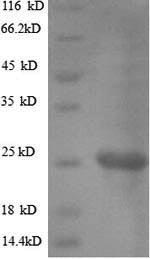This protein is a recombinant H.pylori vacA protein with N-terminal 6xHis tag. Its purity is 90% determined by SDS-PAGE. The production includes 5 steps. 1, obtain the cDNA from the respective mRNA; 2, Select expression vector to insert the vacA sequence and get the recombinant plasmid of vacA; 3, Clone the recombinant plasmid into E.coli; 4, Express the vacA protein in the E.coli cell; 5, Protein purification. And finally, the desired recombinant protein was obtained. In addition, the activity has been tested.
vacA is a gene encoding a protein called vacuolating cytotoxin autotransporter (also known as vacuolating cytotoxin). vacA protein contains a signal peptide that mainly guides the autotransporter protein to the periplasmic space and is cleaved at the inner membrane. In Helicobacter pylori, vacA is a critical virulence factor, is considered a multifunctional toxin, responsible for eliciting several different effects on host cells, including vacuolization, necrosis, and apoptosis. Increasing evidence indicates that the Helicobacter pylori VacA can promote progressive vacuolation and gastric injury and may be associated with human gastric cancer.


-1.jpg)
-2.jpg)




